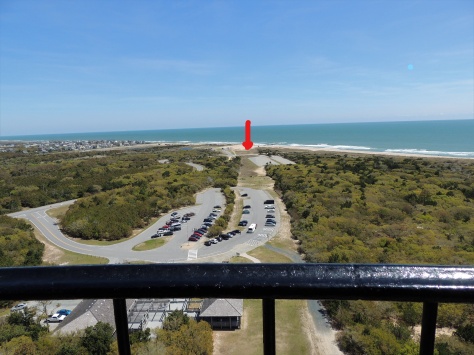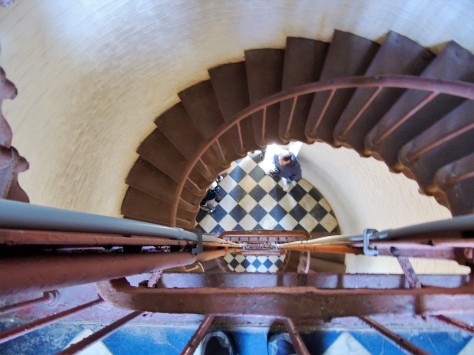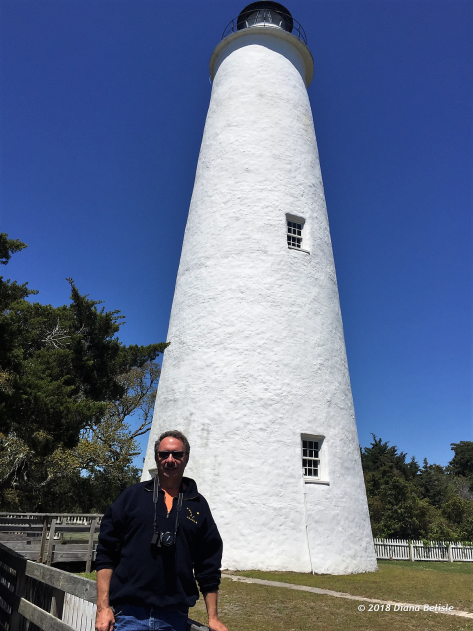
On the northernmost tip of the Lower Peninsula of Michigan is a place that is near and dear to our family…Old Mackinac Point. On this ground in 1892, my maternal great-grandfather led his crew in building Old Mackinac Point Lighthouse and the barn that stands behind it. The light station had been established three years before, and the first fog signal building became operational in 1890. A request for bids for the lighthouse and barn went unanswered, and the second request in March of 1892 solicited three bids, with my great-grandfather’s being the lowest at $13,722.00. He gathered his work party and boarded the lighthouse tender Amaranth at the Detroit Lighthouse Depot for the journey to Mackinaw City.

John Peter Schmitt was born in Germany in 1844. He and his brother came to the United States in the 1870’s and took up the construction trade in Detroit. The bell tower on St Joseph Catholic Church in Detroit is his work, as is St Anthony’s Catholic Church, just up Gratiot Avenue. Both are still in use today. He and my great-grandmother had four girls who all died within a month of each other in a diphtheria epidemic that swept through Detroit in the late 1800’s. They had and lost a fifth child following that. They then had three more children, with my grandmother being the middle child. My great-grandfather was 40 years old when she was born. He lived until 1904, when his spirited horse took a corner in Detroit too fast and tipped his wagon over. He cut his hand in the dirt street and developed tetanus, from which he died eight days later. Another nine years past before my grandmother married. She gave birth to my mother at 38 years old and my mom had me when she was 36. So while my great-grandfather and I are genetically close, there are 114 years separating our births!
When the crew arrived in Mackinaw City in May of 1892, work began in earnest. By October 25th, the first lighting of the lamp took place in the tower. Considering the building is a two-story all-brick duplex, complete with basement, that was quite a feat!

Here is the crew out in front of the partially completed lighthouse. John Schmitt is directly below the double set of windows in the castle tower section of the building. The next person to the right in the white shirt is his brother Tony. The lens has yet to be installed in the tower in this photo. If you look to the far left of the image, there is a horse poking its head in.
The lighthouse continued to guide ships through the Straits of Mackinac until 1957, when the Mackinac Bridge was completed. The bridge’s lights were more than sufficient to provide safe passage after that. For a short time after, the State of Michigan operated a maritime museum from the building, but no access to the tower was permitted. Eventually, the museum closed.
In the 1990’s, my Aunt Marge visited the grounds and then wrote to the Mackinac State Historic Parks (MSHP) to inquire on the building’s status. Diana and I visited not long after that, and we were concerned that this beauty was being left to decay. MSHP’s focus at that time was aimed towards the forts it maintains in both Mackinaw City and on Mackinac Island. Interest in lighthouses was really beginning to take off, and this was one of the most easily accessed lighthouses in Michigan. It deserved to be opened, and in 1996, I began pressuring MSHP to do something. It wasn’t long before they suggested I join a fund raising committee to raise the funds to restore the lighthouse. I took them up on that suggestion, and made several trips from Grand Rapids to Mackinaw City over the next few years to work with them.

Here is a February photo of mine from one of my trips up there. Note the red and white lantern room, which was not historically correct. The radio tower was also not part of the original station, and was moved off the property in later years.
One of the questions I had was the whereabouts of the Fresnel lens. I was told that it was destroyed when they tossed it off the tower after the lighthouse closed. Turns out, it had actually been residing in the U.S. Coast Guard Ninth District Admiral’s office in the Federal Building in Cleveland, Ohio. I contacted that office about being able to see the lens. With permission granted, Diana and I made the trip to Cleveland.

This is my photo from that day. A young Coast Guard officer gave us a special tour of the office. There were several artifacts, but none as beautiful as our lens. There was a small ceremonial cannon on the floor next to the lens, and the officer explained to us that the gun was there to signify that it was guarding something of great importance. It sure was important to us! To think that my great-grandfather was there to see it lit for the first time was overwhelming, to say the least. It was obvious that the admiral treasured the lens, but Coast Guard rules stated that he had to return it to its original home, once the lighthouse had a proper place to display it on the first floor in a museum setting. Senator Carl Levin’s office helped in making sure that happened.
In 2004, after a successful fundraising campaign, the lighthouse reopened. Diana and I decided to host a family reunion of every descendant we could find of John Peter Schmitt to coincide with the grand opening. Of the 300 people attending the celebration, 100 were our family. Some of them travelled up from Marathon, Florida and Missouri to be part of the event. The reason I pushed MSHP so hard was for the family…especially John Peter Schmitt’s grandchildren. As I write this today, almost all of his grandchildren have passed. The two of us were thankful that we were able to make it all happen while they were still alive.
A little magic happened that day. Not only were the descendants of the builder there, but also of the lighthouse keepers. One of the keeper’s relatives recognized one of my cousins, as their children attended the same high school north of Detroit. Both were unaware of each other’s ties to the lighthouse. That was a special moment. 🙂
At the time of the grand opening, the only structures remaining at the light station were the lighthouse and the 1907 fog signal building. In the ensuing years, MSHP replicated the picket fence and the original fog signal building. They also returned the barn to the site, which had been moved to the west side of Mackinaw City a number of years before. Below are photos from our latest visit to the light station, which we toured on our way home from the U.P.

Looking north along the west side of the lighthouse, the proximity to the Mackinac Bridge can be seen. Note the brown grass from the current drought conditions in the area. The tire tracks in the yard are from the recent construction of the replicated 1890 fog signal building. The lantern room is back to its original black, and the picket fence has been replicated.

Standing watch for 123 years, the tower shows the effects of the harsh weather conditions at the Straits of Mackinac. The bricks that the U.S. Lighthouse Service provided for construction were not the proper quality for the application, and the freeze/thaw cycles in the area began to cause them to deteriorate prematurely. This has been an ongoing problem and there is no clear solution…short of re-bricking the entire structure. In the previous photo, note the chimneys. The original flared chimneys were replaced with straight rectangles at some point during the lighthouses working years, and MSHP has recently replicated one of them to its 1892 form.

The 1907 fog signal building, built three years after my great-grandfather passed. This building now serves as a gift shop and as the entrance to the station grounds. The original 1890 fog signal building was constructed too close to where the lighthouse was intended to sit, and was deemed a fire hazard. It was moved to the southeast corner of the station as a storage barn, and was eventually torn down.

This is the barn John Peter Schmitt’s crew built. It is in need of a paint job, which appears to be in process. The building was moved to the west side of Mackinaw City, prior to the construction of I-75 and the Mackinac Bridge. It was being used as a storage garage by MSHP In that location. To bring it back, the trailer tires had to be deflated a little to fit the barn (minus the cupola) under the Mackinac Bridge approach. Even then, there was green bridge paint that ended up on the peak of the barn’s roof. 🙂 Once it was returned to the station grounds, the structure was restored to its original appearance. It now houses a theater that shows a video about the shipwrecks in the straits.

Here is the newly replicated 1890 fog signal building, situated in the location the original structure occupied during its service as a light station warehouse. The corrugated cladding gives the exterior of the building an authentic feel.

The interior of the building houses a beautiful shipwreck museum. There are several displays with models of the original ships as they appeared on the surface, and the corresponding model of how each shipwreck currently sits at the bottom of the Straits of Mackinac. This is the display of the 604 foot limestone carrier Cedarville, which was lost in heavy fog off Old Mackinac Point in 1965. It collided with a Norwegian freighter, killing ten crewmembers. It lies in two pieces in 110 feet of water. Kudos to MSHP on this addition to the light station, as it is very well done.
Inside the lighthouse itself, some of the rooms are restored to their 1910 appearance. Other rooms have interactive displays. The lens is also displayed behind a glass partition.

Tower tours are conducted every 15 minutes. When I began working with MSHP to reopen the building, the director informed me that the tower would not be opened to the public, for safety reasons. I knew that the museum’s success was dependent on public access to the tower, and we didn’t see eye-to-eye on the subject. Who wants to visit a lighthouse and not be able to climb the tower? When that director took a job in Pennsylvania and Phil Porter took over his position, everything changed. Tower tours became the featured attraction at the lighthouse, and the attendance numbers reflected that.

The unique ascending tower windows, as seen from the inside.
 The view from the lantern room looking down at the roof of the lighthouse, and the other structures on the station property. The only buildings that are missing from the grounds are the cast iron oil house and the privy. I’m not sure if there are plans for replicas of those in the future, or not.
The view from the lantern room looking down at the roof of the lighthouse, and the other structures on the station property. The only buildings that are missing from the grounds are the cast iron oil house and the privy. I’m not sure if there are plans for replicas of those in the future, or not.

Looking north, the Mackinac Bridge stretches out for 5 miles to the Upper Peninsula of Michigan.

This graceful structure is what rendered the light station obsolete. When it is lit up at night, it is pretty obvious to passing ships.

Needless to say, our family is pretty darn proud to have this lighthouse still standing, and to be open for future generations to discover. If you find yourselves in Mackinaw City, take an hour and tour this special place. We think you will enjoy it. 🙂
45.008056
-85.683340















































































































